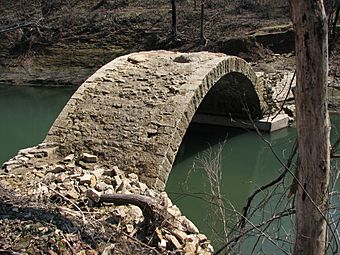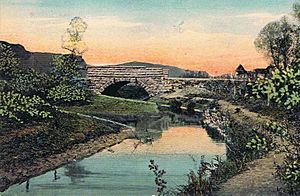Bridge No. L1409 facts for kids
Quick facts for kids Bridge No. L1409 |
|
|---|---|
|
Formerly listed on the U.S. National Register of Historic Places
|
|

The stone arch after flooding in 2007 washed away the rest of the bridge
|
|
| Location | Township Road 62 over Garvin Brook, Hillsdale Township, Minnesota |
| Nearest city | Stockton, Minnesota |
| Area | Less than one acre |
| Built | 1895 |
| Built by | Charles Butler |
| Architect | Fred H. Pickles |
| Architectural style | Stone arch bridge |
| Demolished | 2007 |
| MPS | Minnesota Masonry-Arch Highway Bridges MPS |
| NRHP reference No. | 90000978 |
| Significant dates | |
| Added to NRHP | July 5, 1990 |
| Removed from NRHP | November 7, 2016 |
Bridge No. L1409, also known as the Garvin Brook Bridge, was a special stone arch bridge built in 1895. It was located in Hillsdale Township, Minnesota. This bridge was very old and important, so it was added to the National Register of Historic Places in 1990. This means it was recognized for its importance in engineering.
People thought it was Minnesota's "most impressive" rural stone arch bridge. This was because it had beautiful stone work (called ashlar masonry) and a long span of about 45 feet (13.7 meters). Sadly, in 2007, a big flood destroyed most of the bridge. Only the strong stone arch was left. A new, modern bridge has since been built in its place. The old bridge was officially removed from the National Register in 2016.
Building the Garvin Brook Bridge
In September 1894, people living in Hillsdale Township asked Winona County to build a bridge here. Their request was approved, and plans were drawn up by Fred H. Pickles, the county surveyor.
In October 1895, the county looked for someone to build the bridge. A local stonemason named Charles Butler offered the lowest price, $1,340, and was chosen. The bridge was mostly finished by December of that same year.
Why This Bridge Was Special
Bridge No. L1409 was one of many stone arch bridges built in Southeast Minnesota around the late 1800s and early 1900s. Most of these bridges were built by local governments. This was part of a movement to create "Good Roads" for easier travel.
However, most of these bridges were quite small, usually less than 15 feet (4.6 meters) long. Bridge L1409 was much longer, about three times that length! Also, Charles Butler's stone work was very good. This made Bridge L1409 as impressive as the bigger, more complex bridges found in Minnesota's cities.
The 2007 Flood
In the summer of 2007, there was extreme flooding in Southeast Minnesota. Huge amounts of water rushed down Garvin Brook. The floodwaters tore away the bridge's side walls (called spandrel walls) and the earth fill that supported the road.
Even though the rest of the bridge was washed away, the stone arch itself was built so strongly that it stayed in place. But because so much of it was gone, the bridge was considered destroyed. A new, modern bridge now stands where the historic Garvin Brook Bridge once was.




